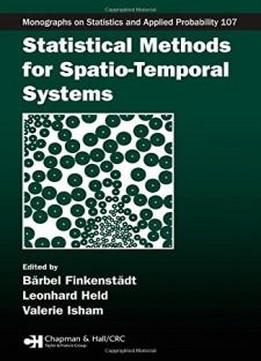
Statistical Methods For Spatio-temporal Systems (chapman & Hall/crc Monographs On Statistics & Applied Probability)
by Barbel Finkenstadt /
2006 / English / PDF
10.3 MB Download
Statistical Methods for Spatio-Temporal Systems presents current
statistical research issues on spatio-temporal data modeling and
will promote advances in research and a greater understanding
between the mechanistic and the statistical modeling
communities.
Statistical Methods for Spatio-Temporal Systems presents current
statistical research issues on spatio-temporal data modeling and
will promote advances in research and a greater understanding
between the mechanistic and the statistical modeling
communities.
Contributed by leading researchers in the field, each
self-contained chapter starts with an introduction of the topic and
progresses to recent research results. Presenting specific examples
of epidemic data of bovine tuberculosis, gastroenteric disease, and
the U.K. foot-and-mouth outbreak, the first chapter uses stochastic
models, such as point process models, to provide the probabilistic
backbone that facilitates statistical inference from data. The next
chapter discusses the critical issue of modeling random growth
objects in diverse biological systems, such as bacteria colonies,
tumors, and plant populations. The subsequent chapter examines data
transformation tools using examples from ecology and air quality
data, followed by a chapter on space-time covariance functions. The
contributors then describe stochastic and statistical models that
are used to generate simulated rainfall sequences for hydrological
use, such as flood risk assessment. The final chapter explores
Gaussian Markov random field specifications and Bayesian
computational inference via Gibbs sampling and Markov chain Monte
Carlo, illustrating the methods with a variety of data examples,
such as temperature surfaces, dioxin concentrations, ozone
concentrations, and a well-established deterministic dynamical
weather model.
Contributed by leading researchers in the field, each
self-contained chapter starts with an introduction of the topic and
progresses to recent research results. Presenting specific examples
of epidemic data of bovine tuberculosis, gastroenteric disease, and
the U.K. foot-and-mouth outbreak, the first chapter uses stochastic
models, such as point process models, to provide the probabilistic
backbone that facilitates statistical inference from data. The next
chapter discusses the critical issue of modeling random growth
objects in diverse biological systems, such as bacteria colonies,
tumors, and plant populations. The subsequent chapter examines data
transformation tools using examples from ecology and air quality
data, followed by a chapter on space-time covariance functions. The
contributors then describe stochastic and statistical models that
are used to generate simulated rainfall sequences for hydrological
use, such as flood risk assessment. The final chapter explores
Gaussian Markov random field specifications and Bayesian
computational inference via Gibbs sampling and Markov chain Monte
Carlo, illustrating the methods with a variety of data examples,
such as temperature surfaces, dioxin concentrations, ozone
concentrations, and a well-established deterministic dynamical
weather model.











